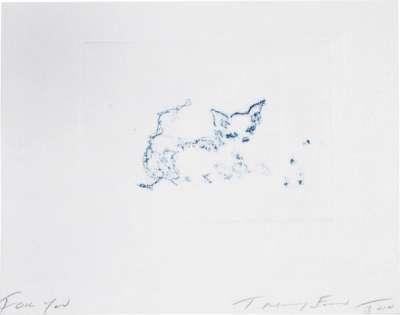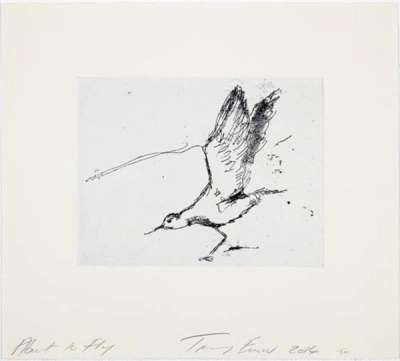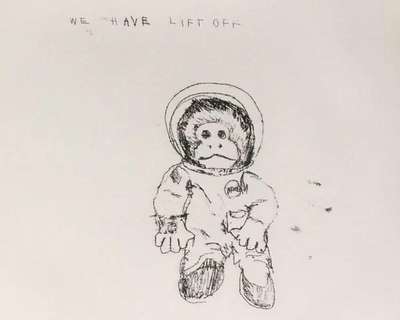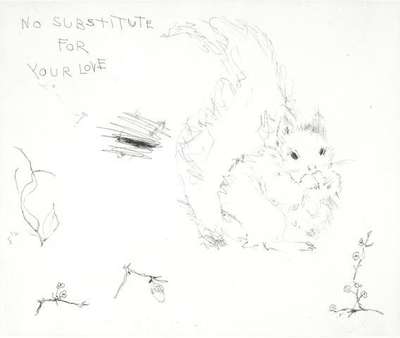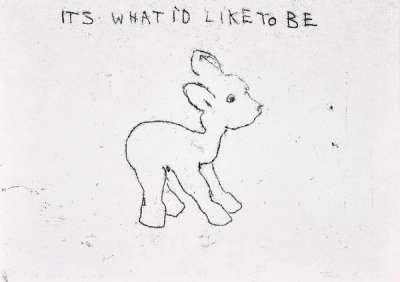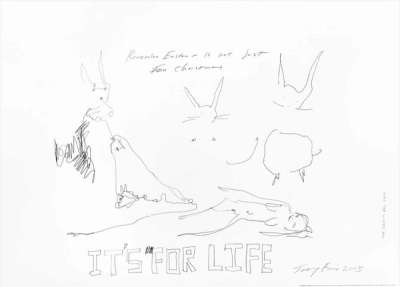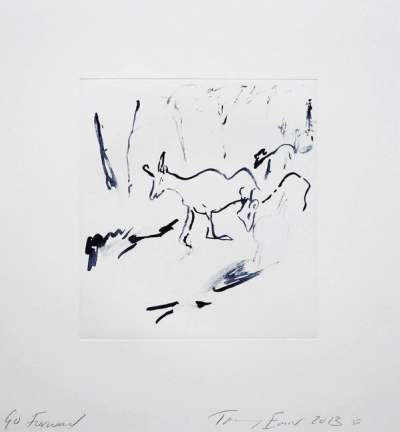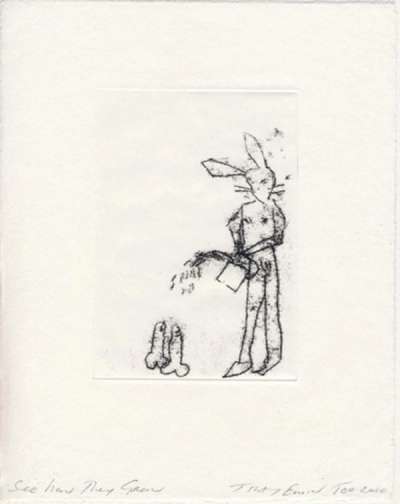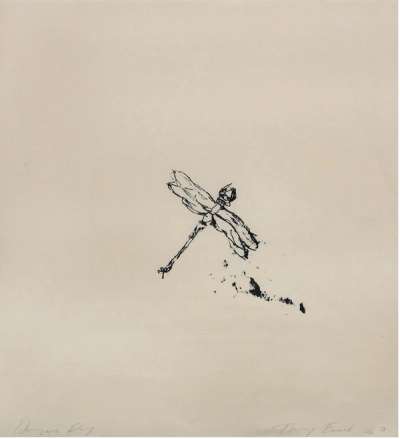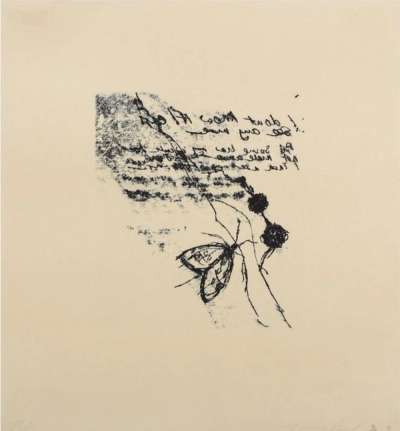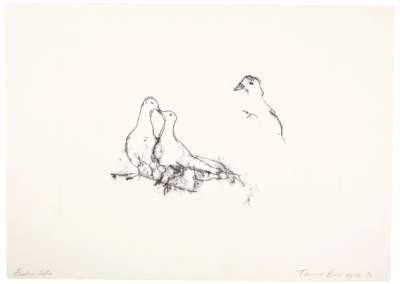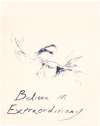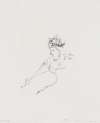Animals
These works by Tracey Emin showcase the human condition imbued in animal forms. Her minimalist illustrations of owls, deers, cats, and rabbits reveal the unique beauty and disarray of life. The contexts presented are elusive, as the artist’s thoughts surface only to disappear, as ephemeral as her delicate sketches.
Tracey Emin Animals For sale
Animals Value (5 Years)
With £23380 in the past 12 months, Tracey Emin's Animals series is one of the most actively traded in the market. Prices have varied significantly – from £137 to £5000 – driven by fluctuations in factors like condition, provenance, and market timing. Over the past 12 months, the average selling price was £2597, with an average annual growth rate of 11.47% across the series.
Animals Market value
Auction Results
| Artwork | Auction Date | Auction House | Return to Seller | Hammer Price | Buyer Paid |
|---|---|---|---|---|---|
 Space Monkey Tracey Emin Signed Print | 24 Sept 2025 | Anderson & Garland | £2,380 | £2,800 | £3,500 |
 Little Owl Tracey Emin Signed Print | 3 Sept 2025 | Lama | £1,743 | £2,050 | £2,850 |
 It's What I'd Like To Be Tracey Emin Signed Print | 19 Mar 2025 | Forum Auctions London | £3,655 | £4,300 | £5,500 |
 No Substitute For Your Love Tracey Emin Signed Print | 19 Mar 2025 | Tate Ward Auctions | £1,743 | £2,050 | £2,750 |
 Moth Tracey Emin Signed Print | 5 Oct 2024 | Tennants Auctioneers | £510 | £600 | £700 |
 Dragon Fly Tracey Emin Signed Print | 5 Oct 2024 | Tennants Auctioneers | £808 | £950 | £1,150 |
 Go Forward Tracey Emin Signed Print | 15 Jun 2024 | Tennants Auctioneers | £1,360 | £1,600 | £1,900 |
 About To Fly Tracey Emin Signed Print | 26 Apr 2024 | Lyon & Turnbull Edinburgh | £1,530 | £1,800 | £2,400 |
Sell Your Art
with Us
with Us
Join Our Network of Collectors. Buy, Sell and Track Demand
Meaning & Analysis
British artist Tracey Emin was born in Croydon, on the cusp of south London, in 1963. She was raised by her single mother in Margate, on the coast of Kent, along with her twin brother Paul. Young Emin emerged into the thick of the blooming technicolour age of ‘The Swinging Sixties’. This was a period ruled by a youth-driven cultural revolution that emphasised modernity and indulgence.
Emin’s academic career began at Medway College of Design in Kent, where she studied fashion. She then also achieved a Master’s in Painting from the Royal College of Art in London. She has been appointed as Professor of Drawing at the Royal Academy of Arts since 2011.
Over the course of the late 1980s, Emin joined forces with members of the Young British Artists group patroned by gallerist Charles Saatchi. The creative collective worked specifically on adding a previously rare commercialist dimension to artistic practice. Emin first came to the attention of the wider public when she appeared intoxicated among a panel of academics on a television show about the Turner Prize in 1997. Two years later, the artist herself was nominated for the award for her notoriously controversial work, My Bed (1998).
Themes of trauma, such as assault, disorders and abortion, soon came to define Emin’s artworks. Her choice to utilise needlework and appliques placed her creative endeavours within a tradition of feminist discourse about “low art” and “women’s work” early on. In particular, Emin's art influences a generation of female artists who explore womanhood and gender politics through a self-confessional tone.
Drawing lies at the heart of Emin’s outstanding artistry. She is technically accomplished and genuinely interested in the media she professes. She is an expressionist whose jagged contours convey emotion through the tone and texture of a roughly, rapidly scrawled line. Her drawings masterfully capture our anxiety at being human when confronted with the complexities of life.
Emin’s works on paper portray love, humans, and various types of animals, which is the focus of this collection of works. The Animal grouping includes It’s What I’d Like To Be, Little Owl, For You, No Substitute For Your Love, and Rabbits, It’s For Life. These drawn pieces showcase the human condition translated into shapes borrowed from the animal kingdom. The artist here manifests raw sentiments and intellect through what might perhaps be considered the most fragile art form. Her minimalist illustrations of owls, deers, cats, and rabbits are specially designed to reveal both the unique beauty and the disarray of life. The sudden and blunt psychological abyss of these drawn pieces is offset by the shakiness of their execution. The contexts presented are elusive, as the artist’s thoughts surface only to then disappear. Yet, the impression of a perpetually amused person behind each composition remains.
This collection is fierce, devoted and exquisitely constructed. Every character is rooted deeply in Emin’s faith in ideas and her hope in the promise of each new day. There is a rhythm to the sensibilities captured in Animals, as Emin skilfully presents a fragmented and associative network of drawn mementoes.
